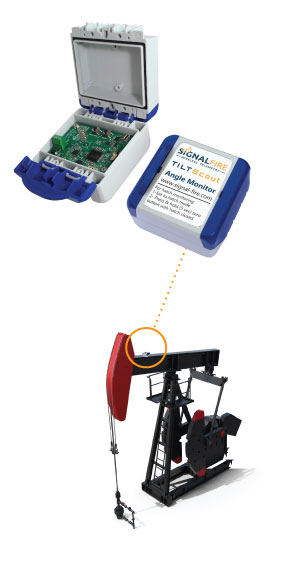Understanding the operational status of tank hatches and pump jacks at any given time is essential to maintain oil field productivity and regulatory compliance. SignalFire introduces a new multi-purpose wireless inclinometer that can monitor the status of tank hatch position or pump jack motion as part of a SignalFire Remote Sensing System. The patent-pending Tilt SCOUT uses a three-axis sensor that continually monitors angle to detect the orientation of a tank hatch or the motion of a pump jack. With feedback from the wireless sensor, workers can determine if a tank hatch is ajar and/or a pump jack is idle, and can take immediate corrective action to ensure proper and compliant operations.
TANK HATCH MONITORING
Oil fields contain many tanks that store a variety of volatile liquids. Most have hatches that provide workers access inside the tanks to take samples, monitor levels, or perform maintenance. When ajar, the tank hatches, also known as thief hatches, can release vapors into the atmosphere creating an immediate hazardous condition or a longer-term environmental situation. Stringent regulations governing uncontrolled emissions can result in substantial fines.
In addition to federal rules issued by the U.S. Environmental Protection Agency for monitoring of emissions, states have local requirements aimed at controlling vapors venting from these tanks. For example, the Colorado Department of Public Health and Environment poses fines of $15,000 a day for an open tank hatch or one visibly emitting emissions. Other oil-producing states may soon follow Colorado’s lead with tighter emission regulations.

The C1D1-certified TiltSCOUT helps mitigate environmental and safety risks associated with accidental emissions from tanks by monitoring the angle of the hatch to determine if it is opened, closed, or partially opened. Attached to the tank hatch, the TiltSCOUT reports hatch status (and any changes of hatch state) to a central Gateway that transmits data to a control center for remote monitoring. With feedback from the angle sensor, operators can quickly respond to any deviation from a hatch-close position to avoid hazardous emissions. Modbus or digital alarming is available at the Gateway of the remote monitoring and control network.
This maintenance-free, non-contacting sensor incorporates a 900mHz radio and antenna for long-range data transmissions (up to ½ mile), and an internal battery pack that supports offers long-term operation of more than five years.
Photo 1 depicts how the Tilt SCOUT installs on top of tank hatches to monitor position to determine if the hatch is open, closed or partially closed. Multiple Tilt SCOUTS can integrate with each other into one wireless remote monitoring network to provide feedback on the status of different hatches. Software dashboards make it easy to monitor the output of different Tilt SCOUTS located throughout an oil field.
IS THE PUMP JACK MOVING?
 A pump jack is a common sight in the oil field used to mechanically extract crude oil out of a non-self-flowing well. Hundreds of thousands of existing pump jacks in North America are not instrumented and utilize wired sensors as part of remote monitoring systems. The Tilt SCOUT offers a wireless alternative to monitoring pump jack operations.
A pump jack is a common sight in the oil field used to mechanically extract crude oil out of a non-self-flowing well. Hundreds of thousands of existing pump jacks in North America are not instrumented and utilize wired sensors as part of remote monitoring systems. The Tilt SCOUT offers a wireless alternative to monitoring pump jack operations.
When working in pump jack mode, the Tilt SCOUT detects the pump jack’s cyclical up-and-down motion to verify operations and report on/off events so operators can quickly resolve issues if a pump unexpectedly stops. Instead of wiring sensors to the device, the angle sensor magnetically attaches to the pump jack without any tools (See Photo 2). Operators simply hand-mount the unit in any orientation. No calibration or zeroing is required in pump jack mode.
The Tilt SCOUT offers a simple integration into a supervisory system like a SCADA. As in tank hatch monitoring mode, the TiltSCOUT sends data to a Gateway that formats it for use at a control center. Modbus or digital alarming is available at the Gateway. C1D1-certified for use in hazardous locations, the Tilt SCOUT has an operating range of ½ mile and a battery life of more than five years.
